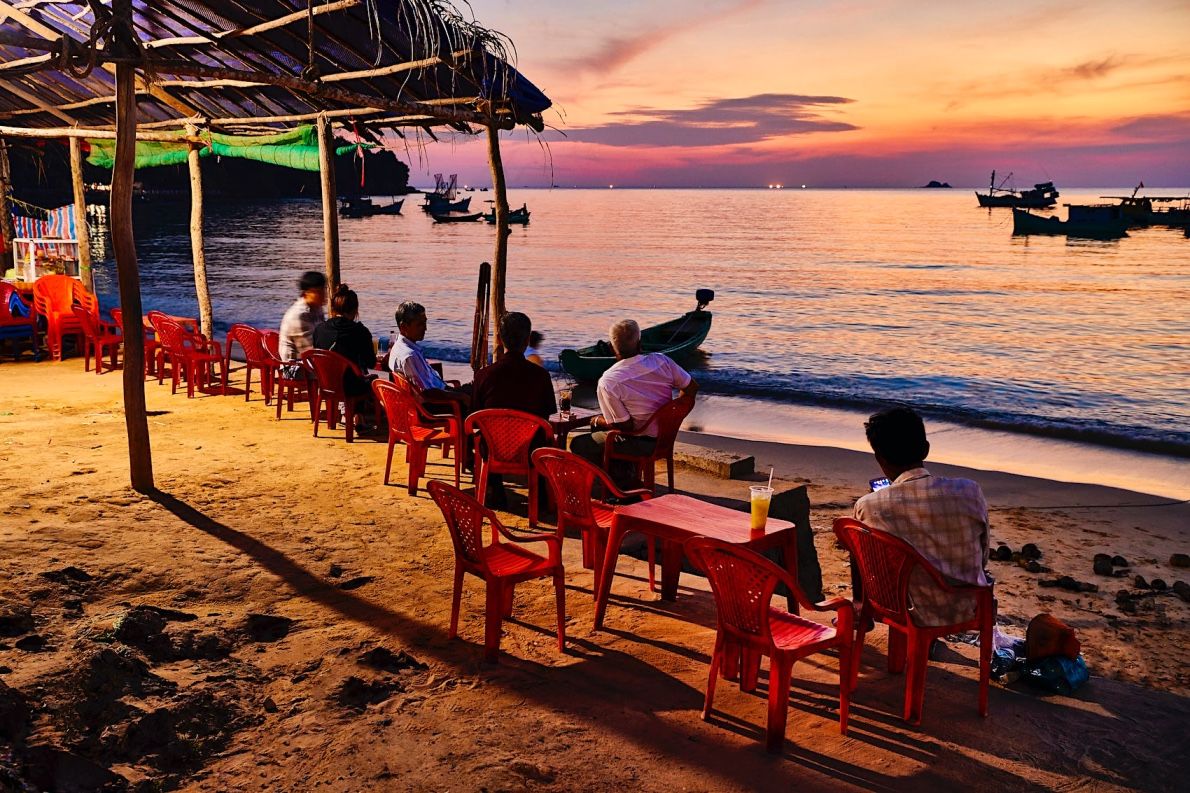When Is the Best & Worst Time to Visit Vietnam in 2025?
Vietnam beckons in any season, but picking the optimum Best Time To Visit comes down to what you crave from a trip most: optimum beach weather? Cultural festivals? Fewer tourist crowds? A combination of all three? If you’re visiting Hanoi, in the north of Vietnam, the capital city experiences cold and dry winters and hot and humid summers. Spring and autumn are the most ideal times to visit with warmer temperatures and lower humidity.
Tropical Saigon is usually warm all year round and dry during the winter and spring months. Popular times to visit are October to December. Saigon’s rainy season falls in the summer months, but these rain spells often clear quickly.
Explore Vietnam Your Way → Book a packages tours to see the country your way: a vibrant city, rural villages and hill-tribes, and picture-perfect beaches.
Explore all of its corners on a Best Deal Vietnam Tours & Trips

Regional breakdown: Primary tourist seasons in Vietnam
- High Seasons: North: September to November, March and April; Central: April to August; South: October to April.
- Shoulder Seasons: North: December to February, May to August; Central: September to March; South: September to December.
- Low Season: North: May to October; Central: September to May; South: May to September.
The best months of the year to visit Vietnam
Different region means different weather, Vietnam’s climate is vary and before planning any trip, find out when to visit where. The best times to visit Vietnam for hiking the lush high mountains and the cascading rice terraces in Sapa, cruising the Halong Bay, and, when to go to avoid the rainy (worst) monsoon season.
July & August: Best Months for beach lovers
July and August are the busiest (high-season months) to visit Vietnam, with prices increasing by up to 30% by the coast; book hotels well in advance. The whole country, except the far north, is hot and humid, punctuated by spectacular summer monsoon downpours. The climate of Vietnam varies considerably from region to region. Although the entire country lies in the tropics and subtropics, local conditions vary from frosty winters in the far northern hills to year-round, subequatorial warmth in the Mekong Delta.
December to March: Best seasons to visit Hanoi & Ho Chi Minh City
Winter in Vietnam is usually drier than the summer months, but also colder. Expect chilly conditions in the north including Hanoi, but in the far south, clear skies and sunshine are the norm. If big cities are your thing, shoulder season is a pleasant time to visit both Hanoi and Ho Chi Minh City, with reliable weather and good temperatures. Although, during the Tet festival (late January or early February), the whole country is on the move and hotel prices rise.
Head out to the Mekong Delta and the island of Phu Quoc in the south to see more of Vietnam; this is a great time, with warm temperatures and clear blue skies. However, as April approaches, the mercury climbs to uncomfortable levels of hot weather down south.
Another obstacle to convenient travel is the Tet festival—officially designated as Tet Nguyen Dan—which signifies the Vietnamese lunar New Year in late January or early February. Traveling during this time, the entire country experiences heightened movement, and prices for transportation and accommodation escalate significantly.
Best months to Visit for Smaller Crowds (Low Season)
Visit from April to June and September to November to avoid the crowds – Low season in Vietnam falls on the transition period from winter to summer and summer to winter, offering unsettled weather that can provide glorious days of sunshine, but also days of rain. It’s a great time to visit for those who want to avoid tourist crowds, or those looking to tour the whole country (with weather not notably awful anywhere).
This is also a good time to tour Halong Bay, with weather relatively reliable in this region during these months, particularly October and November.
Compare the Weather in Hanoi, Ho Chi Minh City & Hoi An
| Hanoi | |||
|---|---|---|---|
| Month | Min Temp °C | Max Temp °C | Rainfall mm |
| Jan | 15 | 19 | 21 |
| Feb | 15 | 20 | 28 |
| Mar | 18 | 23 | 46 |
| Apr | 21 | 26 | 92 |
| May | 24 | 33 | 185 |
| Jun | 25 | 35 | 230 |
| Jul | 25 | 35 | 240 |
| Aug | 26 | 32 | 280 |
| Sep | 25 | 31 | 255 |
| Oct | 22 | 28 | 140 |
| Nov | 19 | 24 | 45 |
| Dec | 15 | 23 | 15 |
| Ho Chi Minh City | |||
|---|---|---|---|
| Month | Min Temp °C | Max Temp °C | Rainfall mm |
| Jan | 22 | 32 | 12 |
| Feb | 22 | 32 | 10 |
| Mar | 24 | 33 | 10 |
| Apr | 26 | 33 | 50 |
| May | 26 | 33 | 210 |
| Jun | 25 | 30 | 300 |
| Jul | 25 | 31 | 295 |
| Aug | 25 | 31 | 270 |
| Sep | 24 | 31 | 345 |
| Oct | 24 | 30 | 260 |
| Nov | 23 | 29 | 110 |
| Dec | 22 | 28 | 40 |
| Hoi An | |||
|---|---|---|---|
| Month | Min Temp °C | Max Temp °C | Rainfall mm |
| Jan | 19 | 24 | 100 |
| Feb | 20 | 25 | 30 |
| Mar | 22 | 27 | 30 |
| Apr | 23 | 30 | 30 |
| May | 25 | 31 | 60 |
| Jun | 26 | 32 | 75 |
| Jul | 26 | 33 | 90 |
| Aug | 26 | 32 | 100 |
| Sep | 25 | 31 | 300 |
| Oct | 23 | 28 | 540 |
| Nov | 22 | 26 | 330 |
| Dec | 20 | 23 | 215 |
Vietnam Weather by month - When to go
Visit Vietnam between months of November to April for the best holiday experience.
It is best to divide the weather in Vietnam by region. In Hanoi and the north, expect hot and humid conditions with high rainfall from May to October; however, from November to April, enjoy cooler and drier weather. The far north can get particularly cold in December and January.
In Southern Vietnam, the period from November to April remains generally dry and hot, while from May to October, the weather turns warm and wet, with the highest rainfall occurring in June, July, and August.
Vietnam January weather overview
It’s a tough call if you’re deciding to visit Vietnam in the month of January as the weather is so diverse form one region to another. Think frosts and occasional snow in the mountains of the far north such as Sapa & Ha Giang, and temperatures soaring to 40°C in the south during the dry season.
Weather in February
North of Danang, chilly ‘Chinese winds’ usually mean grey, overcast conditions. Conversely, sunny hot days are the norm in the southern provinces. February also welcomes Tet, Vietnamese New Year. Travel is difficult at this time, as transport is booked up and many businesses close.
Tet It’s a nice idea in principle, but not in practice, as the whole country is on the move and prices rise dramatically. Transport is crammed in the run-up and aftermath, the Reunification Express booked far in advance during festivities, flights rise up to 50%, and most shops and businesses are closed for the best part of a week.
Visiting Vietnam in March
Visiting Vietnam in the month of March when the weather is dictated by two monsoons, meaning double trouble on the rain front. The winter monsoon comes from the northeast between October and March, bringing damp and chilly winters to all areas north of Nha Trang, and dry and warm temperatures to the south.
Weather of Vietnam in April
Vietnam's Weather in May
Visit Vietnam in month of June
A great time to holiday in Vietnam as it’s just before the peak domestic season. Humidity can be punishing at this time of year, so plan to spend some time by the coast. Celebrated biannually in early June, Nha Trang Sea Festival whips the city into a frenzy with a street festival, photography exhibitions, sports events, embroidery displays and kite-flying competitions.

Is Vietnam good to visit in July?
Vietnam weather August
Weather of Vietnam in September
September marks the start of Vietnam’s second annual low season, and is an excellent time to tour the whole Vietnam from top to toe. The coastal resorts are less crowded and there are fewer people on the move. Temperatures and humidity levels drop too. Big parades and events are held across Vietnam on 2 September for Vietnam National Day. Celebrations are particularly fervent in Hanoi, with a rally and fireworks at Ba Dinh Square (in front of Ho Chi Minh’s Mausoleum). Hanoi Pride also comes to town towards the end of the month, adding to the September festivities.
September is also considered as top season to visit Rice Terraces in Vietnam




